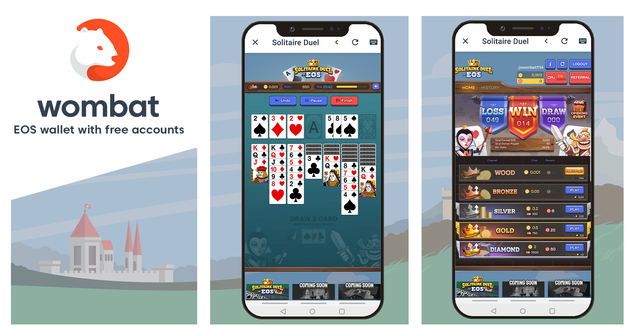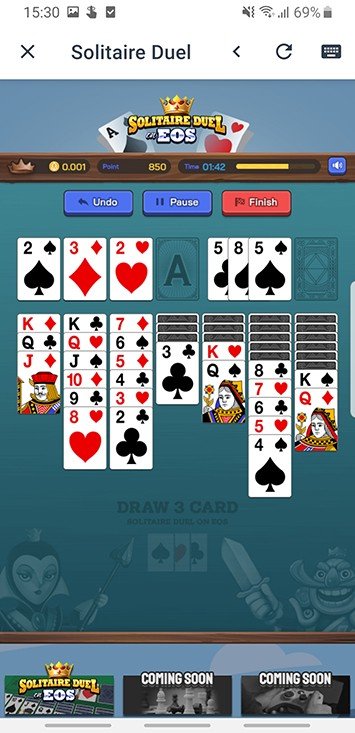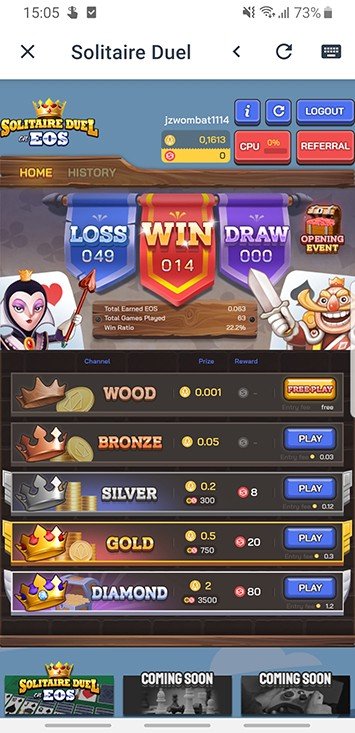Solitaire Duel Beginner’s Guide

In this part of our beginner’s guide series we are covering the dApp Solitaire Duel — most likely the best blockchain based Solitaire game ever.
The traditional Solitaire game has been very popular since Microsoft launched its Windows version. Since then it has been a perfect game to kill (spare) time at office desks around the world, testing a player’s combinatorial skills. Solitaire Duel is same same but different to other Solitaire versions. By adding blockchain and multiplayer game mechanics the game becomes a whole new deal, making it even more addictive than it was before.
The basic rules of the game also apply for Solitaire Duel.
In essence, the goal of Solitaire is to build up four piles of cards on the so-called build table. Those piles need to be sorted by type (hearts, diamonds, spades, clubs) and in ascending order, starting with aces as the foundation.
On the pursue to reach that goal cards can be picked from tableau- and draw-piles and arranged on the tableau table. The card build up on the tableau-piles follows a descending order and the colors of piled cards have to alternate. The game setup looks like this:

In case you don’t know the rules and want to learn more then have a look at this well illustrated game description: https://www.wikihow.com/Play-Solitaire
But what is different in Solitaire Duel?
Despite having decent Solitaire skills it happens that a game is unsolvable. This is due to the fact that the initial card set up is random. Hence, Solitaire has a bit of a gambling character to it and can make one freak out when multiple games in a row get stuck at some point. There are a few strategies which increase the chance of succeeding but in the end it is mostly a matter of probabilities.
This is where playing Solitaire Duel follows a different approach. In Solitaire Duel one can win a game even though the card set up is unsolvable. The big difference is its player versus player modus. A player gets a competitor assigned and both have to solve the same arrangement. The competition factor abstracts away the gambling factor and adds extra motivation to play again and again. In order to win it is only necessary to score more points than the opponent — easier said than done.
Scoring principles
A player’s score is determined by collecting or losing points as follows:
- Each card stacked on another, unveiling a new card, brings +20 points.
- Each card placed on a build pile brings +50 points.
- The time of each game is limited to 5mins. Players get a time-score for ending the game before the time runs out. In many cases the time-score makes the difference between win and loss.
- In case you flipped through all the cards in the draw pile without using any, your score will shrink by 20 points per flip through.
There are a few scoring principles you should have in mind in when competing. Apart from arranging cards in the best possible way you should do the following in order to get to your maximum final score:
- Play fast and don’t underestimate the time-score. In case the game ends early and without clearing, the likeliness of the opponent getting stuck as well is quite high. The faster you realize it’s over and end the game the better the chances are of you getting a higher time-score than the competitor.
- Even the -20 points you get for flipping through the draw pile once to much can make a difference in close matches. Again, realize it’s over when it’s over.
- When you think that the game is over and no card can be moved anymore, make sure that really nothing can be put on the build piles. Especially when having big tableau piles one or two single cards can be overlooked easily.
- There is an undo button to reverse the last move made. In case there are two options to choose from and the one picked doesn’t bring any progress then “Undo” and try the other option.
Since it’s blockchain based — what does it cost to play?
In order to play SD each player has to pay an entrance fee per round. A won match leads to prize money which is of course higher than the paid fee. The match-result-tracking as well as the transfer of the fees and prize money is being done and ensured through smart contracts on the EOS blockchain. Interested players can track their games here: https://bloks.io/account/Solitaireapp
There are five different tiers to play. All having a different entrance fee and prize money. Tiers being: Wood (Entry fee: 0.0006 EOS; Prize: 0.001 EOS), Bronze (Entry fee: 0.03 EOS; Prize: 0.05 EOS), Silver (Entry fee: 0.12 EOS; Prize: 0.2 EOS), Gold (Entry fee: 0.3 EOS; Prize: 0.5 EOS), Diamond (Entry fee: 1.2 EOS; Prize: 2 EOS). Players can expect the competition to be harder in higher tiers, since experienced players may be more confident to win, hence being more risk-affine. So beginners may not want to play diamond first. But going for the lower tiers cost so less that a loss doesn’t “hurt” and winning makes even more fun than playing a free version of Solitaire without competition. By having a win ratio above 50% you can also earn the fee for higher tiers through earning prize money in lower tiers.
The following picture shows the SD “Lobby” with an overview of tiers and a player’s stats:

On mobile devices SD can be played best with Wombat. So if you are hyped, download Wombat here and start playing right away. Also make sure to follow us on Twitter for feature and partnership announcements. For any feedback and inquiries join our Telegram community.
Hi wombatapp, did you know you can also view this post on Steemie?
I'm a bot, if you do not want these messages under your posts - just reply STOP :)
Ads (powered by Steemie)